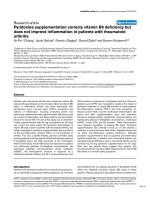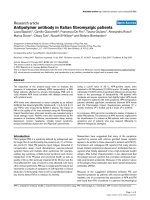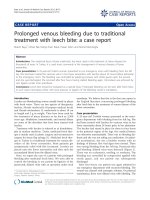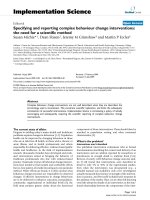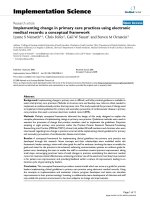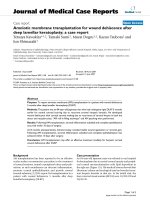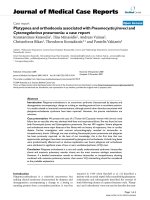Báo cáo y học: "Selenium supplementation in critically ill patients: can too much of a good thing be a bad thing" potx
Bạn đang xem bản rút gọn của tài liệu. Xem và tải ngay bản đầy đủ của tài liệu tại đây (187.33 KB, 3 trang )
Page 1 of 3
(page number not for citation purposes)
Available online />Abstract
A recent study by Forceville and colleagues evaluated the effect of
high-dose selenium administration as a treatment for septic shock.
The study was negative and conflicts with existing clinical data
regarding selenium administration in critically ill patients. Perhaps
the key to understanding the differences between these discrepant
observations lies in considering the dose and timing of selenium
administration.
Selenium is an essential nutrient for all mammalian species,
and in this issue of Critical Care Forceville and colleagues [1]
evaluated the effect of high-dose selenium administration as a
treatment for septic shock. Low levels of plasma selenium
have been observed in critically ill patients and are associated
with increased markers of oxidative stress, worse organ
failure, and higher mortality rates [2]. Increasing levels of
selenium are correlated with increased glutathione peroxidase,
a key endogenous antioxidant defense mechanism [3]. These
observations have given rise to several studies providing
exogenous selenium, at doses less than 1,000 µg/day, to
critically ill patients. Overall, these antioxidant supplemen-
tation strategies are associated with a large beneficial
mortality effect (risk ratio (RR) 0.69, 95% confidence interval
(CI) 0.59 to 0.82) [4].
However, selenium compounds can also be considered ‘pro-
oxidative’. As the authors suggest, the pro-oxidant properties
of selenite may be beneficial early in the course of septic
shock if they reduce inflammation either by inhibiting the
activation of NF-κB or by inducing a pro-apoptotic effect on
activated circulating cells [1]. Nevertheless, at some level, the
pro-oxidative effect of selenium may become toxic to humans.
Their toxicity is thought to be due to the pro-oxidant ability of
selenium compounds to catalyze the oxidation of thiols and
simultaneously generate superoxide (O
2
–
), thus causing a
depletion of intracellular glutathione, excessive oxidative
stress, and cell death [5]. The toxicity of selenium is clearly
dose dependent and varies depending on the type of
selenium compound administered [5].
Forceville and colleagues attempt to take advantage of this
dual effect of selenium in treating septic shock by
administering a high, pro-oxidant dose (4,000 µg) on study
day 1, followed by an antioxidant dose of 1,000 µg/day for an
additional 9 days. In a randomized trial of 60 patients with
severe sepsis, they were unable to detect any treatment
effect of this selenium administration strategy. Why do their
findings contradict those of the recent meta-analysis [4],
which suggests a large decrease in mortality?
Perhaps the underlying rationale is unsound? At a theoretical
level, inducing apoptosis of cells causing a maladaptive
inflammatory reaction by means of a pro-oxidative mechanism
may be beneficial. However, no evidence of any beneficial
anti-inflammatory effect of high-dose selenium is provided,
either in the study by Forceville and colleagues or in any other
published study of septic patients or in septic animal models.
In contrast, inducing apoptosis of beneficial cell lines (such
as intestinal epithelial cells) may be harmful. Perhaps a high
dose (more than 1,000 µg/day) of selenium increases
oxidative stress and leads to glutathione depletion and
increased cell death. This dosing strategy may therefore
actually be harmful, negating or overwhelming any beneficial
effect of a subsequent lower-dose selenium administration.
Support for this assertion comes from the fact that the
incidence of multiorgan failure in selenium-treated patients in
the Forceville study was more than double that of patients in
the control group (32% versus 14%, P = 0.09). This large
treatment effect lacked statistical significance because of the
small sample size, but it should not be ignored.
Commentary
Selenium supplementation in critically ill patients: can too much
of a good thing be a bad thing?
Daren K Heyland
Clinical Evaluation Research Unit, Angada 4 Kingston General Hospital, Kingston, ON K7L 2V7, Canada
Corresponding author: Daren K Heyland,
Published: 7 August 2007 Critical Care 2007, 11:153 (doi:10.1186/cc5975)
This article is online at />© 2007 BioMed Central Ltd
See related research by Forceville et al., />CI = confidence interval; RR = risk ratio; TBARS = thiobarbiturate acid-reducing substrates.
Page 2 of 3
(page number not for citation purposes)
Critical Care Vol 11 No 4 Heyland
Perhaps the timeliness of the study interventions may have
affected the study results. On average, the study medications
were started 24 hours after admission to the intensive care
unit. Thus, more than 50% of patients would have had their
study medication started more than 24 hours after the onset
of shock. There is some evidence that oxidative stress leading
to mitochondrial dysfunction becomes irreversible within 6 to
24 hours after the onset of tissue hypoxia [6,7]. Thus, for anti-
oxidant strategies to be effective, they must be administered
as soon as possible after the onset of shock.
So what is the optimal dose of selenium in critically ill patients
in shock? The meta-analysis we published in 2005 suggests
that studies using a higher dosing strategy of selenium (more
than 500 µg/day) showed a tendency towards a decrease in
mortality (RR 0.52, 95% CI 0.24 to 1.14, P = 0.10), whereas
studies that used a lower dose did not demonstrate any
effect on mortality (RR 1.47, 95% CI 0.20 to 10.78,
P = 0.70) [2]. These data have been updated with recent
evidence that seems to suggest that the higher the dose, the
more likely is a positive treatment effect on mortality (see
Figure 1, which shows that low-dose studies starting at the
top are associated with negative or no treatment effect and
that the higher-dose studies at the bottom tend towards a
positive treatment effect). Building on these data, we recently
published the first dosing study of its kind that asked this
specific question: What is the optimal dose of selenium and
other antioxidants in critically ill patients? We studied a range
of doses of selenium from 0 to 800 µg/day in a series of
critically ill patients with either septic or cardiogenic shock
[8]. We measured the effect of the various doses of selenium
and other antioxidants on glutathione, thiobarbiturate acid-
reducing substrates (TBARS), mitochondrial function, and
organ failure. This study was designed as a safety study, and
as we escalated the dose of selenium to 800 µg/day we
observed no deterioration in organ function. More importantly,
we observed greater preservation of glutathione (greater
antioxidant capacity), fewer TBARS (less oxidative stress),
and improved mitochondrial function.
Our main inference from this dosing-optimizing study was
that supplementation with 800 µg of selenium (in combina-
tion with other antioxidants) was safe. We are now moving
forward with a large-scale multicenter trial of 1,200 patients
to evaluate whether such a dose has a positive effect on
mortality [9]. The answer to the question posed above will
therefore have to wait for the completion of this study, but in
the mean time I suggest that doses greater than
1,000 µg/day could be harmful and doses less than
800 µg/day may not be optimal in critically ill patients.
Competing interests
The author declares that they have no competing interests.
References
1. Forceville X, Laviolle B, Annane D, Vitoux D, Bleichner G, Korach
J-M, Cantais E, Georges H, Soubirou J-L, Combes A, Bellissant
EB: Effects of high doses of selenium, as sodium selenite, in
septic shock: a placebo-controlled, randomized, double-blind,
phase II study. Crit Care 2007, 11:R73.
2. Heyland DK, Dhaliwal R, Suchner U, Berger M: Antioxidant nutri-
ents: a systematic review of vitamins and trace elements in
the critically ill patient. Int Care Med 2005, 31:327-337.
3. Berger MM, Baines M, Chiolero R, Wardle CA, Cayeux C,
Shenkin A: Influence of early trace element and vitamin E sup-
plements on antioxidant status after major trauma: a con-
trolled trial. Nutr Res 2001, 21:41-54.
4.
5. Spallholz JE: On the nature of selenium toxicity and carcinos-
tatic activity. Free Radic Biol Med 1994, 17:45-64.
6. Suliman HB, Welty-Wolf KE, Carraway MS, Tatro L, Pianttadosi
CA: Lipopolysaccharide induces oxidative cardiac mitochondr-
ial damage and biogenesis. Cardiovasc Res 2004, 64:279-288.
Figure 1
Effect of selenium on mortality: dose–response curve. Studies are listed in order of the dose of selenium. CI, confidence interval; RR, risk ratio.
Page 3 of 3
(page number not for citation purposes)
7. Frost MT, Wang Q, Moncada S, Singer M: Hypoxia accelerates
nitric oxide-dependent inhibition of mitochondrial complex 1
in activated macrophages. Am J Physiol Regul Integr Comp
Physiol 2005, 288:R394-R400.
8. Heyland DK, Dhaliwal R, Day A, Drover J, Cote H, Wischmeyer P:
Optimizing the dose of glutamine dipeptides and antioxidants
in critically ill patients: a phase I dose-finding study. J Par-
enteral Enteral Nutr 2007, 31:109-118.
9. Heyland DK, Dhaliwal R, Day AG, Muscedere J, Drover J, Suchner
U, Cook D; Canadian Critical Care Trials Group: REducing
Deaths due to OXidative Stress (The REDOXS Study): ratio-
nale and study design for a randomized trial of glutamine and
antioxidant supplementation in critically-ill patients. Proc Nutr
Soc 2006, 65:250-263.
10. Berger MM, Spertini F, Shenkin A, Wardle C, Wiesner L,
Schindler C, Chioléro RL: Trace element supplementation
modulates pulmonary infection rates after major burns: a
double-blind, placebo-controlled trial. Am J Clin Nutr 1998, 68:
365-371
11. Porter JM, Ivatury RR, Azimuddin K, Swami R: Antioxidant
therapy in the prevention of organ dysfunction syndrome and
infectious complications after trauma: early results of a
prospective randomized study. Am Surg 1999, 65:478-483
12. Berger MM, Baines M, Wardle CA, Cayeux MC, Chiolero R,
Shenkin A: Trace element supplements modulate tissue
levels, antioxidant status and clinical course after major burns -
preliminary results. Clin Nutr 2002, 21(Suppl 1):66
13. Berger MM, Recmond MJ, Shenkin A, Rey F, Wardle C, Cayeux
C, Schindler C, Chiolero: Influence of selenium supplements
on the post-traumatic alterations of the thyroid axis: a
placebo-controlled trial. Intensive Care Med 2001, 27:91-100
14. Kuklinski B, Buchner M, Schweder R, Nagel R: Akute Pancreati-
tis-eine "Free Radical Disease:. Letalitatssenkung durch Natri-
umselenit (Na2SeO3)-Therapie. Z Gestame Inn Med 1991, 46:
S145-149
15. Angstwurm MW, Schottdorf J, Schopohl J, Gaertner R: Sele-
nium replacement in patients with severe systemic inflamma-
tory response syndrome improves clinical outcome. Crit Care
Med 1999, 27:1807-1813
16. Angstwurm MW, Engelmann L, Zimmermann T, Lehmann C, et al.:
Selenium in Intensive Care (SIC): results of a prospective ran-
domized, placebo-controlled, multiple-center study in patients
with severe systemic inflammatory response syndrome,
sepsis, and septic shock. Crit Care Med 2007, 35:118-26.
17. Zimmermann T, Albrecht S, Kühne H, Vogelsang U, Grützmann R,
Kopprasch S: Selensubstitution bei Sepsispatienten. Med Klin
1997, 92(Suppl III):3-4
Available online />

